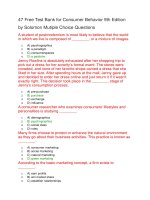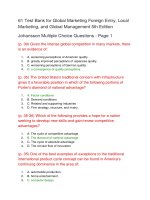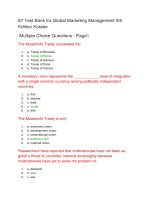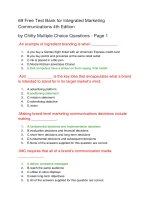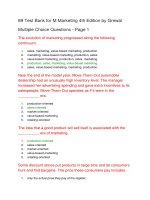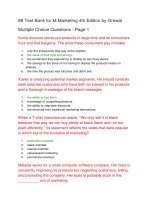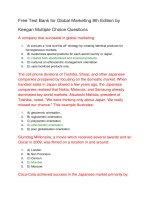Free test bank for global marketing 8th edition by
Bạn đang xem bản rút gọn của tài liệu. Xem và tải ngay bản đầy đủ của tài liệu tại đây (57.68 KB, 17 trang )
Free Test Bank for Global Marketing 8th Edition by
Keegan Multiple Choice Questions
A company that succeeds in global marketing:
1.
2.
3.
4.
5.
A) pursues a "one size fits all" strategy by creating identical products for
homogeneous markets.
B) customizes special products for each world country or region.
C) creates both standardized and localized products.
D) nurtures an ethnocentric management orientation.
E) uses localized products only.
The cell phone divisions of Toshiba, Sharp, and other Japanese
companies prospered by focusing on the domestic market. When
handset sales in Japan slowed a few years ago, the Japanese
companies realized that Nokia, Motorola, and Samsung already
dominated key world markets. Atsutoshi Nishida, president of
Toshiba, noted, "We were thinking only about Japan. We really
missed our chance." This example illustrates:
1.
2.
3.
4.
5.
A) geocentric orientation.
B) regiocentric orientation.
C) polycentric orientation.
D) ethnocentric orientation.
E) poor globalization orientation.
Slumdog Millionaire, a movie which received several awards and an
Oscar in 2009, was filmed on a location in and around:
1.
2.
3.
4.
5.
A) London.
B) San Francisco.
C) Cancun.
D) Mumbai.
E) Moscow.
Coca-Cola achieved success in the Japanese market primarily by:
1.
2.
3.
4.
5.
A) standardization of marketing mix elements.
B) global localization.
C) vending machine operations.
D) selecting market mix options.
E) homogenization.
One of the dimensions of global marketing strategy which pertains
to marketing management is:
1.
A) concentration of market penetration.
2.
3.
4.
5.
B) coordination of market diversification.
C) integration of competitive moves.
D) coordination of product development.
E) product standardization.
Pfizer, Merck, Novartis, and other pharmaceutical companies have
little choice but to engage in global marketing since:
1.
2.
3.
4.
5.
A) there is little demand for their products in home countries.
B) their research centers are located overseas.
C) no single market is large enough to recover costs incurred in research.
D) there is more demand overseas for their products.
E) technology is not available in home countries.
The marketing mix is integral to the value equation which is
represented by:
1.
2.
3.
4.
5.
A) Value = Price/Benefits.
B) Value = Benefits/Price.
C) Value = Benefits × Price.
D) Value = Benefits - Price.
E) Value = Benefits + Price.
Walmart's exit from the German market was due, in part, to the fact
that German shoppers could find lower prices at stores known as:
1.
2.
3.
4.
5.
A) All-in-one stores.
B) Dollar stores.
C) Discount sores.
D) Hard discounters.
E) Fresh & Easy stores.
Based on the size of the market in U.S. dollars, the leading
consumer products are:
1.
2.
3.
4.
5.
A) cell phones.
B) bottled water.
C) cigarettes.
D) video games.
E) recorded music.
Nestlé, Unilever, GlaxoSmithKline, and Royal Philips Electronics
can be considered transnational companies on the basis of:
1.
2.
3.
4.
5.
A) sales outside the home country to total sales.
B) assets outside the home country to total assets.
C) employees outside the home country to total employees.
D) headquartered in a relatively small home-country market.
E) all of the above
Nissan's earlier vehicles were difficult to start in many parts of the
United States during the cold winter months. In northern Japan, it
was customary for many car owners to put blankets over the hoods
of their cars during winter months. Nissan's assumption was that
Americans would do the same thing. This is an example of:
1.
2.
3.
4.
5.
A) ethnocentric orientation.
B) polycentric orientation.
C) regiocentric orientation.
D) geocentric orientation.
E) geopolitic orientation.
A person who assumes that his or her home country is superior to
the rest of the world is said to have:
1.
2.
3.
4.
5.
A) ethnocentric orientation.
B) polycentric orientation.
C) regiocentric orientation.
D) geocentric orientation.
E) None of the above
Nike recently adopted the slogan "Here I am" for its pan-European
clothing advertising targeting women. The decision to drop the
famous "Just do it" tag line was based on the research indicating
that:
1.
2.
3.
4.
5.
A) the famous slogan did not have accurate translation in European
languages.
B) Europeans do not like tag lines that portray American thinking.
C) college-age women in Europe are not as competitive about sports as men
are.
D) the old slogan conveys superiority of men over women.
E) European women want to differentiate themselves from men.
A fundamental difference between regular marketing and global
marketing is:
1.
2.
3.
4.
5.
A) the lack of marketing mix.
B) the scope of activities.
C) the lack of strategic planning.
D) the focus on resources.
E) the lack of communication.
Based on the total annual units sold in the worldwide market, the
leading product category is:
1.
2.
A) flat-panel TV sets.
B) cigarettes.
3.
4.
5.
C) cell phone handsets.
D) cars and light trucks.
E) HDTV sets.
Starbucks has launched several new ventures in global markets,
including music CDs and movie production. This is an example of:
1.
2.
3.
4.
5.
A) Market Penetration.
B) Market Development.
C) Market Diversification.
D) Product Development.
E) Global Marketing.
In global markets, Starbucks is a good example of simultaneously
executing all of the growth strategies except:
1.
2.
3.
4.
5.
A) Market penetration.
B) Market development.
C) Product development.
D) Market orientation.
E) Diversification.
The decision to enter one or more particular markets outside the
home country depends on all of the mentioned factors except:
1.
2.
3.
4.
5.
A) company's resources.
B) company's age.
C) company's managerial mind-set.
D) nature of opportunities.
E) threats.
McDonald's serves McAloo Tikki Burger in India, McRice Burger in
Malaysia, McOZ Burger in Australia, Kiwi Burger in New Zealand,
and McHuevo Burger in Uruguay and McSamurai Burger in
Thailand. These menu variations are examples of:
1.
2.
3.
4.
5.
A) a combination of global and local marketing mix elements.
B) a reflection of failure of U.S. menu items in those countries.
C) a deviation from successful marketing practices.
D) a replacement of standard menu names with fancy names.
E) a selection of menu items that can be sold eventually in U.S. markets.
According to Michael Porter, a global industry is one in which
________ can be achieved by integrating and leveraging operations
on a worldwide scale.
1.
2.
3.
A) marketing mix
B) competitive advantage
C) cross border infiltration
4.
5.
D) ration analysis
E) production capability
Starbucks is building on its loyalty card and rewards program in the
United States with a smartphone app that enables customers to pay
for purchases electronically. The app displays a bar code that the
barista can scan. This is an example of:
1.
2.
3.
4.
5.
A) Market Penetration.
B) Market Development.
C) Market Diversification.
D) Product Development.
E) Global Marketing.
Measured by national income, the United States represents the
world's largest single market for goods and services. Roughly what
percentage of world income is found outside the United States?
1.
2.
3.
4.
5.
A) 25%
B) 50%
C) 75%
D) 95%
E) 35%
Anheuser-Busch, the brewer of Budweiser beer, lost its
independence after years of focusing primarily on the domestic U.S.
market. This is most likely a result of:
1.
2.
3.
4.
5.
A) management myopia.
B) national controls.
C) opposition to globalization.
D) newcomers from emerging markets.
E) organizational culture.
The essence of marketing worldwide is to surpass the competition
in creating perceived value, which can be represented as:
1.
2.
3.
4.
5.
A) Value = Price/Benefits.
B) Value = Benefits/Price.
C) Value = Benefits × Price.
D) Value = Benefits - Price.
E) Value = Benefits + Price.
Based on 2012 rankings of Fortune Global 500 companies, the
world's most valuable car company is:
1.
2.
3.
A) GM.
B) Daimler AG.
C) Toyota.
4.
5.
D) Ford.
E) Chrysler.
In their book, Daniel Yergin and Joseph Stanislaw wrote "It is the
greatest sale in the history of the world. Governments are getting
out of businesses by disposing of what amounts to trillions of dollars
of assets. Everything is going—from steel plants and phone
companies . . . to hotels, restaurants, and nightclubs." This is an
indication of:
1.
2.
3.
4.
5.
A) the fact that governments can make more money by selling assets.
B) privatization is becoming a driving force for global marketing.
C) these businesses are considered as closed markets.
D) foreign companies are competing with governments.
E) there is less demand for these type of companies.
Starbucks is entering India via an alliance with the Tata Group.
Phase 1 calls for sourcing coffee beans in India and marketing them
at Starbucks stores throughout the world. This is an example of:
1.
2.
3.
4.
5.
A) Market Penetration.
B) Market Development.
C) Market Diversification.
D) Product Development.
E) Regular Marketing.
Renault and its rivals are racing to offer middle-class consumers a
new value proposition by selling cars for the equivalent of $10,000
or less. On the heels of Renault's success with Dacia Logan came
the $2,500 Nano from India's Tata Motors. This illustrates that:
1.
2.
3.
4.
A) consumers are looking for low price irrespective of quality.
B) Renault is overcharging for their cars compared to their competitors.
C) higher product development costs are a driving force behind globalization.
D) market success depends on reaching a threshold of acceptable quality for
consumers.
5. E) cars are not very popular in emerging markets like India.
Even though Germany is the largest single-country market in
Europe, what percent of the world market potential for German
companies is outside Germany?
1.
2.
3.
4.
5.
A) 40%
B) 55%
C) 74%
D) 94%
E) 85%
Based on the size of the market in U.S. dollars, the second highest
consumer products are:
1.
2.
3.
4.
5.
A) luxury goods.
B) cell phones.
C) cigarettes.
D) bottled water.
E) recorded music.
When a country like China is experiencing rapid economic growth,
policymakers are likely to:
1.
2.
3.
4.
5.
A) look more favorably on outsiders.
B) look less favorably on outsiders.
C) experience more resistance toward outsiders.
D) feel threatened by outsiders.
E) None of the above
Examples of effective global marketing by McDonald's include both
standardized and localized marketing mix elements. Which of the
following does not represent a localized element?
1.
2.
3.
4.
5.
A) It serves McAloo tikki potato burger in India.
B) It uses the advertising slogan "I'm lovin' it."
C) It operates themed dining cars on the Swiss national rail system.
D) It has home delivery service in India.
E) It has slang nicknames such as MakDo in Philippines and McDo in France.
Two decades ago, professor Ted Levitt wrote a classic Harvard
Business Review article titled "The Globalization of Markets." Which
of the following statements about the author and the article is
accurate?
1.
2.
A) Levitt urged companies to adopt products on a country-by-country basis.
B) There was universal agreement about his thesis that the world is becoming
homogeneous.
3. C) Levitt urged companies to develop standardized products that could be
marketed worldwide with little adaptation.
4. D) Levitt warned of the coming backlash against globalization.
5. E) Levitt did not recommend developing standardized products.
Unilever, the Anglo-Dutch consumer products company, at one time
had 30 different package designs and 48 different formulations for
its Rexona deodorant brand. This is an example of:
1.
2.
3.
A) ethnocentric orientation.
B) polycentric orientation.
C) regiocentric orientation.
4.
5.
D) geocentric orientation.
E) transnational orientation.
An important managerial task in global marketing is learning to
recognize the extent to which it is possible to extend marketing
plans as well as the extent to which adaptation is desired. The way
a company addresses this task is a reflection of the company's:
1.
2.
3.
4.
5.
A) market penetration.
B) market diversification.
C) global marketing strategy.
D) product development.
E) product standardization.
When you call United Airlines for a reservation on a toll-free number
and get a response from an operator in Mumbai, this is an example
of:
1.
2.
3.
4.
5.
A) anti-globalization.
B) global marketplace.
C) multilingual expression.
D) discrimination.
E) E-ticketing.
A type of advantage that a global company possesses by virtue of
the fact that it has experience in more than one country is referred
to as:
1.
2.
3.
4.
5.
A) Leverage.
B) Transferability.
C) Flexibility.
D) Capability.
E) Enability.
The former chairman of Nestlé recently told an interviewer: "We are
food and beverages. We are not running bicycle shops. Even in
food we are not in all fields. There are certain areas we do not
touch. Also, we have no soft drinks because I have said we either
buy Coca-Cola or we leave it alone." What strategic marketing
principle does the chairman's comment emphasize most
specifically?
1.
2.
3.
4.
5.
A) customer value
B) competitive advantage
C) focus
D) myopia
E) policy of dealing only with Swiss businesses
Transnational companies, such as Toyota and Honda, have
characteristic features that include:
1.
2.
3.
4.
5.
A) being in both global markets and utilizing global supply chains.
B) characterized by a mind-set of being "stateless."
C) using both localized and standardized elements in marketing programs.
D) decisions made on the basis of ongoing research.
E) all of the above
In the United States, some people believe that globalization has
depressed the wages of American workers and resulted in the loss
of both blue-collar and white-collar jobs. This is an example of:
1.
2.
3.
4.
5.
A) discrimination.
B) domination.
C) globaphobia.
D) management myopia.
E) economic crisis.
Statements that illustrate the success of global marketing include all
of the following except:
1.
2.
3.
4.
5.
A) the Coca-Cola Company supports its Coke brand by utilizing global and
local marketing mix.
B) Apple is synonymous with cutting-edge innovation and high-tech design.
C) Italy's Benetton utilizes marketing as a knee-jerk reaction to world
marketing needs.
D) the backbone of Caterpillar's global success is its network of dealers.
E) Germany's reputation for engineering and manufacturing provides a
competitive advantage.
A number of multilateral trade agreements have accelerated the
pace of global integration which include:
1.
2.
3.
4.
5.
A) NAFTA.
B) GATT.
C) WTO.
D) EU.
E) all of the above
According to the Fortune global 500 companies for 2012, the
largest corporation based on revenue is:
1.
2.
3.
4.
5.
A) Exxon Corporation.
B) Toyota Motors.
C) Royal Dutch Shell.
D) General Electric.
E) Walmart stores.
In an effort to "Americanize" the sound of the Beatles' recordings, a
studio effect known as reverb was added to some tracks. This is an
example of:
1.
2.
3.
4.
5.
A) product adaptation.
B) market penetration.
C) diversification.
D) product development.
E) marketing mix.
All of the following correctly states McDonald's approach to
standardization and adaptation of the marketing mix except:
1.
2.
3.
4.
5.
A) McDonald's standardizes some product elements and adapts others.
B) McDonald's standardizes some place elements and adapts others.
C) McDonald's standardizes some promotion elements and adapts others.
D) McDonald's standardizes some price elements and adapts others.
E) McDonald's standardizes all product elements.
Japan's giant Matsushita Electric Company achieved scale
economies by exporting VCRs, televisions, and other consumer
electronics products throughout the world from world-scale factories
in Japan. This is an example of the fact that:
1.
2.
3.
4.
5.
A) scale economies were a cornerstone of Japanese success in the 1970s
and 1980s.
B) leverage from scale economies is not limited to manufacturing.
C) a global company can achieve the same economies on a global scale.
D) the larger scale of the global company also creates opportunities to
improve corporate staff competence and quality.
E) all of the above
Uniqlo, a division of Japan's Fast Retail, operates about 850 stores
in Japan and currently has six stores in the United States. Their
plans call for a total of 200 U.S. stores by 2020. The fulfillment of
their plan will depend on:
1.
2.
3.
4.
5.
A) industry conditions.
B) sources of competitive advantage.
C) the condition of the apparel market worldwide.
D) the demand in Japan for U.S. style garments.
E) all of the above
From the global marketing perspective, the customization of the
Beatles' records is a good example of:
1.
2.
A) product adaptation.
B) market penetration.
3.
4.
5.
C) diversification.
D) product development.
E) marketing mix.
30 Free Test Bank for Selling Today Partnering to Create
Value 13th Edition by Manning Multiple Choice
Questions
Salespeople use social media to:
1.
2.
3.
4.
5.
A) design web pages with product features
B) learn to use administrative software
C) create and maintain customer contact
D) set up mobile offices from their vehicles
E) automate selling so they do not have to make client contact
Well-trained salespeople can add value to the traditional retail
shopping experience. Selling for a retailer might involve which of
the following products?
1.
2.
3.
4.
5.
A) personal computers, automobiles and assembly line robotics equipment
B) photographic equipment, industrial specialties and recreational equipment
C) fashion apparel, personal computers and recreational vehicles
D) microchips, musical instruments and automobiles
E) software back-end integration services, jewelry, and motorcycles
Of the following activities routinely performed by salespeople, which
one contributes LEAST financially to both the salesperson and the
company?
1.
2.
3.
4.
5.
A) service calls
B) face-to-face selling
C) telephone selling
D) waiting and traveling
E) billing clients
Which of the following sectors would NOT be considered to be part
the service industry?
1.
2.
3.
4.
5.
A) hotel
B) insurance
C) banking
D) real estate
E) chemicals
Tamara Grindel is a doctor who practices with a group of other
physicians with the same specialty. She is considering taking a
course on selling skills. What is the most important way in which
this will help her medical practice?
1.
2.
3.
4.
5.
A) Learning selling skills will give Dr. Grindel an alternate career once she
retires from medicine.
B) Learning selling skills will help Dr. Grindel bring new patients to her
practice.
C) Learning selling skills will aid Dr. Grindel in communicating effectively with
pharmaceutical reps who show her new medications.
D) Learning selling skills will show Dr. Grindel how to ensure that her patients
take the medications she prescribes them.
E) Learning selling skills will require Dr. Grindel to understand the financial
pressures of running a practice.
Corporate-sponsored sales training usually includes training on:
1.
2.
3.
4.
5.
A) CRM software
B) accounting methods and theory
C) shipping systems and logistics
D) operating production machinery
E) competitors' products
Which of the following trends in sales has led to an increase in both
the education and skills a salesperson needs?
1.
2.
3.
4.
5.
A) an increase in commission per sale
B) an increase in the time spent on personal relationships
C) an increase in web-based selling channels
D) a shift from in-person to telephone sales
E) a shift from "selling" to "consulting"
Salespeople have an advantage over workers in other positions
when being considered for promotion to positions of greater
responsibilities because salespeople:
1.
2.
3.
4.
5.
A) have limited opportunities for advancement in the sales department
B) are compensated primarily through psychic income
C) have worked for many companies in their careers
D) have numerous opportunities to advance to middle-management ranks
E) have high visibility within companies already relative to other positions
A training and education initiative with specific requirements
delivered by an industry oversight organization to salespeople in
that industry is an example of a(n):
1.
2.
3.
4.
A) university sales methods class
B) corporate-sponsored training class
C) Internet-based training program
D) certification program
5.
E) college concentration
Some top-performing salespeople earn more than their managers.
This compensation is most likely made up of:
1.
2.
3.
4.
5.
A) bonuses only
B) base salary, commissions, bonuses, and incentives
C) commissions and charge-backs
D) bonuses and dividends
E) IPOs and base salary
Commercial vendors who provide sales training offer courses based
on:
1.
2.
3.
4.
5.
A) Universal Sales Theory
B) the theories of Dale Carnegie and Napoleon Hill
C) a variety of sales approaches dating back decades
D) modern sales approaches that have been regression-tested
E) graduate-level MBA sales work
Which one of the following people would LEAST likely be
considered a "knowledge worker"?
1.
2.
3.
A) someone who performs research to discover new information
B) someone who takes current research and uses it to facilitate a task
C) someone who relays information from one party to another without
changing it
4. D) someone who puts information in a format that allows others to access it
5. E) someone who uses information to solve a problem
Which of the following is an activity that would most likely be
performed by a customer service representative (CSR)?
1.
2.
3.
4.
5.
A) processing employee paperwork
B) delivering supplies to the factory floor
C) providing telephone support for installation
D) calling on prospects to sell them the product
E) reconciling bank statements with accounting records
The CEO of SwiftLink spends one week each month going to sales
appointments with various salespeople in the company. In addition
to assisting the salespeople with presentations, a likely reason the
CEO goes on sales calls is to:
1.
2.
3.
4.
5.
A) gather information on customer needs and preferences
B) deduct mileage on his vehicle as a way to offset taxes
C) undercut the salespeople in underperforming divisions of SwiftLink
D) ensure that the salespeople do not give volume discount pricing
E) trade information to customers in exchange for information on competitors
Salespeople are most likely considered knowledge workers
because they:
1.
2.
3.
4.
5.
A) position and lay out information in a way that helps buyers understand it
B) gain knowledge of the product before they can sell it
C) repeat a script that they are given by their managers
D) develop an understanding of the best practices of sales
E) create products themselves before they sell them
Sales opportunities in the service sector are most likely expanding
because:
1.
2.
A) service providers connect directly with consumers
B) the service industry has a higher growth rate than the product industry
does
3. C) modern consumers need help with activities that they used to be able to do
on their own
4. D) the service industry is starting to saturate the market relative to the
industrial and product industries
5. E) the service industry provides a higher commission rate for salespeople
than other industries
Trade selling and missionary (detail) sales are both examples of
sales:
1.
2.
3.
4.
5.
A) directly from the manufacturer to the consumer
B) from the distributor to the consumer
C) bypassing the manufacturer to the distributor
D) inside the supply chain but not to the consumer
E) externally from the consumer to the supplier
Sales engineers are people with extensive knowledge of their
product who also:
1.
2.
3.
4.
5.
A) provide service on the product after the sale
B) develop the product as part of the research and development team
C) communicate the benefits of the product to the customers
D) have advanced degrees in science or technology
E) have graduate-level sales training
Network (multilevel) marketing is different from traditional sales in
that it:
1.
A) creates a pyramid with the CEO at the top and the salespeople at the
bottom
2. B) eschews growth of the salesforce for a given product
3. C) relies on an interconnected network of independent salespeople to sell the
product directly
4. D) focuses on paid advertising instead of word-of-mouth publicity
5.
E) allies itself with competing products and service providers
Salespeople in the U.S. report that they work in sales primarily to:
1.
2.
3.
4.
5.
A) be promoted to management
B) avoid working traditional hours
C) have greater flexibility with retirement
D) make more money
E) generate pension credits
There is a pay gap between men and women in the field of sales,
with men earning more than women do. Despite this, sales
represents an excellent financial opportunity for women for which of
the following reasons?
1.
2.
3.
4.
5.
A) The pay gap in sales is less than the pay gap in the workforce overall.
B) The pay gap varies from company to company.
C) The pay gap is only an issue in certain industries.
D) The psychic income from sales is equivalent to the value of the pay gap.
E) The psychic income from sales cannot be quantified.
What event contributed most to the increased need for
telecommunications salespeople?
1.
2.
3.
4.
5.
A) deregulation of telephone service
B) anti-trust suits brought against the telecommunications industry
C) financial improprieties in the telecommunications industry
D) creation of a national regulatory committee for telephone service
E) development of voice-over-IP (VOIP) technologies
The duties of inside salespeople may overlap heavily with the duties
of:
1.
2.
3.
4.
5.
A) sales managers
B) account managers
C) product developers
D) supply buyers
E) internal auditors
On average, an experienced, high-performing salesperson will find
the highest compensation opportunities with which approach?
1.
2.
3.
4.
5.
A) feature/benefit
B) transactional
C) value-added
D) solution
E) directed
In a well-structured sales department, inside and outside
salespeople often:
1.
2.
3.
4.
5.
A) compete for sales and customers
B) duplicate their efforts and increase the company's cost per sale
C) work together to generate leads, close sales, and provide service
D) exchange leads depending on what the expected sales will be
E) combine their monthly sales figures to increase commissions
Terri Milano, employed by a manufacturer of home electronics,
offers assistance to retailers in such areas as credit policies, pricing
display and store layout. She also collects information regarding
acceptance of her firm's products. She is performing the duties of
a(n):
1.
2.
3.
4.
5.
A) detail salesperson
B) retail salesperson
C) inside salesperson
D) field representative
E) manufacturer's representative
Alan Karbashian spends all day driving from customer site to
customer site for sales meetings in his job with a national medical
parts manufacturer. Alan is considered a/an:
1.
2.
3.
4.
5.
A) inside sales rep
B) outside sales rep
C) alignment rep
D) distributing rep
E) interchange rep
Peter Kumar has developed a software application that will reduce
costs and increase server speed for corporations of all sizes. Even
with this useful application, Peter still needs to develop personal
selling skills in order to:
1.
2.
3.
4.
A) understand and write a business plan for his company
B) explain his application to potential buyers
C) apply for a patent on his application
D) maintain the discipline and stamina required to develop such a complicated
piece of software
5. E) ensure that only corporate users buy his application
Which of the following describes a category of sales personnel in
the field of manufacturing?
1.
2.
3.
4.
5.
A) sales engineer
B) field researcher
C) comptroller
D) technical support representative
E) research and development director
Psychic income in selling most likely refers to which one of the
following?
1.
2.
3.
4.
5.
A) visibility provided by working in the sales department
B) satisfaction of being on a commission payment plan
C) high commissions earned because of successful "intuitive" selling
D) opportunity to be a member of the sales team
E) job recognition afforded sales personnel

